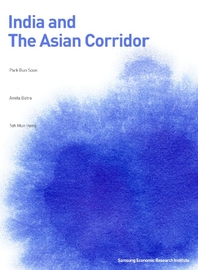

- ���� ������ ź�� : AI �ô� ���� ��ü���� �ʴ�
�̽�ȯ �� | �����ũ�Ͻ�


- �������� �ι� ���� ����
������ �� | ������ȭ��


- �Ǹ��� ��༭�� ���� ���� �ʴ´�
������ �� | ���丮����
- Ȩ >
- ���ͳݺ���Ͻ�


This book speculates on the formation of an "Asian Corridor" that stretches from Northeast Asia through Southeast Asia and into India to from a huge base for production and consumption that encompasses some of the world��s most dynamic economies. The book first consider whether India��s growth is ultimately sustainable, and then examines whether FTAs can be enacted through systematic cooperation between the nations of region; whether between the countries of East Asia and India. To this end, researchers from Korea (Northeast Asia), Singapore(Southeast Asia) and India have all participated in evaluating the feasibility of forming an "Asian Corridor".
With respect to India, India��s economy is likely to experience continued economic growth, as well as an increased presence from multinational corporations. India also enjoys competitive advantage in labor intensive industries, as analysis of its trade statistics will attest. Southeast Asia, on the other hand, enjoys a special role in the Asia Corridor, as it is the core region connecting Northeast Asia to India. From the Northeast Asian perspective, while interest is increasing in Indian businesses, division of labor between the regions has not yet appeared, most likely due to regional fragmentation. Furthermore, India��s low competitiveness in manufacturing industry makes conclusion of deals like an FTA between India and China unlikely within the next ten year.
The authors of this book are not uniform in their evaluations of the short term future of the Asia Corridor. In India, optimism prevails with respect to the future of the Indian economy and the Asia Corridor, while Southeast Asia concentrates on the role of ASEAN. Northeast Asia for its part will require substantial time before it can be said to have any kind of meaningful cooperative relationship with India. Despite these differences, all agree that in light of the potential for growth in the India economy, as well as the potential for the Asia Corridor to be an important site of production and consumption, that the Asian Corridor still has a potentially important role in creating growth for the Asian economy.
���� : Park Bun-Soon et al.
Park Bun Soon(Senior Fellow, Samsung Economic Research Institute)
Amita Batra(Senior Fellow, Indian Council for Research on international Research Relations)
Toh Mun Heng(Associate Professor, Singapore National University)
Chapter I. Introduction: India��s Growth and Cooperation in East Asia
1. Recent Economic Growth of India
2. Economic Prospects
3. Indian Cooperation in East Asian Economy
4. Objectives and Meaning of the Research
Chapter II. India and The Asian Corridor
1. Current economic situation and prospects of Indian economy
2. FTAs between India and East Asia and Prospects
3. Impact of India��s FTAs with East Asia on Division of Labor
4. India��s FDI Policy
5. Conclusions
Chapter III. Southeast Asia and the Asian Corridor
1. Introduction
2. ASEAN��s existing external economic cooperation
3. ASEAN��s Policy Response to Rising India
4. Evaluation of Economic Relation within ASEAN+3 Countries and India
5. Investment Strategies & Implications for MNCs
6. Conclusions and Recommendations
Chapter IV. Northeast Asia and the Asian Corridor
1. The birth of Economic Cooperation between Northeast Asia and India
2. Analysis of Trade Cooperation
3. Direct Investment and Industrial Cooperation
4. The Status and Effects of FTA Promotion between Northeast Asia and India
5. Industrial Specialization between Northeast Asia and India
6. Conclusion


































